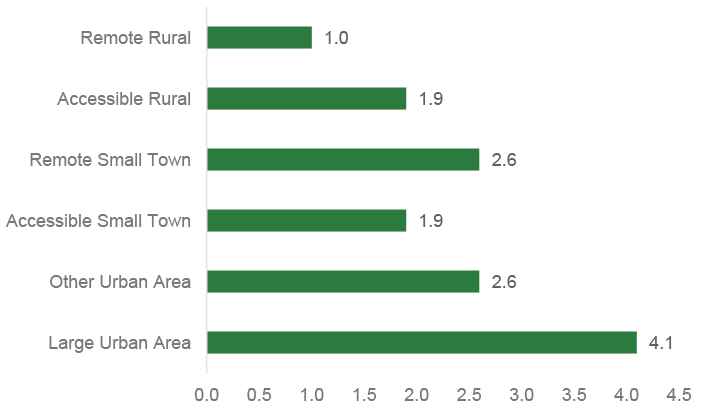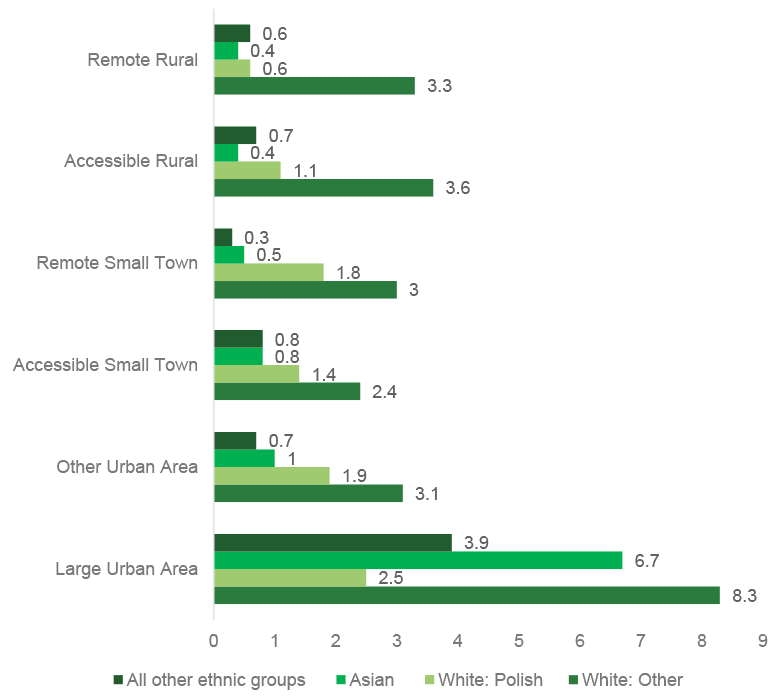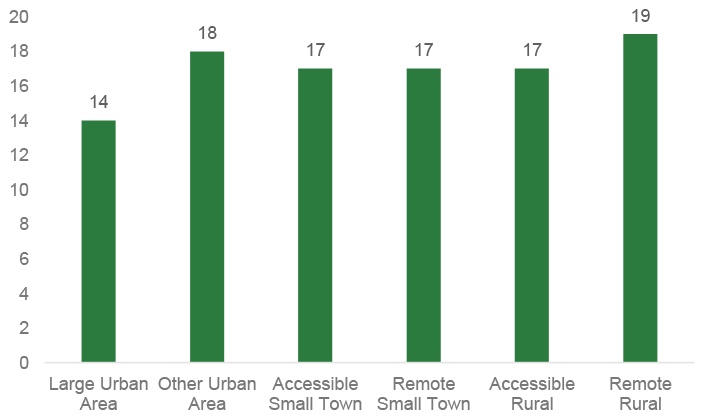Inclusive participation in rural Scotland: research report
Preliminary exploration report details the findings of research into barriers to participation facing lesser heard voices in the context of rural Scotland. Specifically, it focuses on the LGBTI community, disabled people, carers and ethnic minorities.
4 Background
4.1 LGBTI in rural Scotland
Section Summary
- The Social Survey Core Questions (SSCQ) indicate that the lesbian, gay, bisexual, or other (LGBO) population of Scotland is estimated at 2.6%. There is no reliable data on Scotland’s trans population. A higher proportion of the population identify as LGBO in urban areas than in rural.
- The Scottish Government has a history of policy developments promoting equality for Scotland’s LGBTI population. This includes the Marriage and Civil Partnerships (Scotland) Act 2014 and, currently, the reformation of the Gender Recognition Act 2004.
- Previous research highlights the disadvantage experienced by LGBTI people in rural Scotland. This includes social isolation, discrimination, prejudice, and a lack of services. Barriers to participation in rural policy and decision-making may extend from broader social exclusion.
4.1.1 Demographics
The Office of National Statistics (ONS) estimated that, in 2018, the proportion of the Scottish population identifying as lesbian, gay, or bisexual (LGB) was 2% (Office for National Statistics, 2020). Data from the 2019 Scottish Surveys Core Questions....higher estimate of 2.9%. However, includes non-heterosexual orientations other than LGB (designated as ‘other’, and collectively as LGBO) (Scottish Government, 2020c).
We currently do not have reliable data on the size of Scotland’s trans population. The Government Equalities Office, in 2018, observed that there was no robust data on the UK trans population, and provided a tentative estimate of 200,000-500,000 trans people in the UK.[2]
Further, we do not currently have robust data on the number of non-binary people in Scotland. Since 2018, the Scottish Household Survey (SHS) has provided the option for people to describe their gender identity as ‘man/boy,’ ‘woman/girl,’ or ‘in another way’ (Scottish Government, 2020b), resulting in 0.1% defining their gender ‘in another way’ and 0.2% refusing to answer. In 2019, 0.0% of respondents identified ‘in another way’. It should be noted that the SHS does not ask people whether they identify as trans, or have a trans history.
As the Scottish Household Survey notes, however, these figures are likely to under-report the number of people not identifying as a man or woman, or as LGB, owing to a range of factors including but not limited to prejudice/stigma and the possibility that such questions may be considered intrusive.
The 2019 SSCQ[3] provides estimates of Scotland’s LGBO population stratified along the Scottish Government 6 fold Urban Rural Classification and can be seen in Figure 1. As this shows, there is a higher prevalence of people identifying as LGBO in large urban and other areas, including those which are rural. This may partially reflect the fact that, as reported by the Equality Network in 2015 that, concerning those living in rural areas: “Four out of ten LGBT respondents (43%) have either moved, or considered moving, to live in a different area because of being LGBT” (Equality Network 2015: 8).

Figure 1 displays the percentage of the population identifying as LGBO by the Scottish Government’s six-fold urban rural classification. In remote rural, 1% of the population defines themselves in this way. In accessible rural areas and accessible small towns it is 1.9%. In both remote small towns and other urban areas it is 2.6%. In large urban areas it is 4.1%.
4.1.2 Policy developments
In 2014, the Scottish Government introduced the Marriage and Civil Partnership (Scotland) Act. This extended marriage to same-sex couples. Other policy developments introduced include the Adoption and Children (Scotland) Act 2007, allowing same-sex couples to adopt jointly, and the Offences (Aggravation by Prejudice) Act 2009 to address hate crime. More recently the Scottish Government held a public consultation on a draft Gender Recognition Reform (Scotland) Bill. This Bill intends to amend the process by which people can legally obtain gender recognition – originally set out in the Gender Recognition Act 2004 to make it less intrusive (Scottish Government, 2019b). Consultation on the draft Bill ended in March 2020, however the COVID-19 pandemic has resulted in a current suspension of work on the Bill by the Scottish Government.
4.1.3 Previous research
The recent Scottish LGBT Rural Equalities report, published by the Equalities Network, focuses on the experiences of the LGBT community in rural Scotland (Crowther et al., 2020). Presenting findings from both survey and qualitative research, it notably highlights that LGBT people in rural Scotland experience inequality, prejudice, and discrimination, and a lack of both services and social opportunities.
This research was preceded by a 2015 report which provided comparative survey findings between rural and urban settings in Scotland (Equality Network, 2015). This report highlighted that rural LGBT people faced greater social isolation, were more dissatisfied with services, and were more likely to travel outwith their local area to access services than their urban counterparts.
The above research does not explicitly discuss barriers to participation in rural policy or decision-making. However, it is conceivable that the experiences of LGBTI people in rural Scotland could function as barriers, a possibility that finds support within the research presented here. This also finds some support from UK wide research that links barriers to political participation amongst LGBT people to broader social exclusion (e.g. as a result of discrimination or prejudice) (Ryrie et al., 2010).
- Disability is defined as a long-term limiting (‘substantial’) condition or illness lasting, or expected to last, at least 12 months.
- The Scottish Health Survey (SHeS) estimated that, in 2019, 35% of Scotland’s population fall under this definition of being a disabled person. According to the SSCQ, the proportion of disabled people in urban and rural areas varies, but does not appear to vary consistently with the level of rurality in which individual lives.
- A Fairer Scotland for Disabled People Action Plan established the policy direction of the Scottish Government
- This report is not aware of any primary research relating to the experiences of disabled people in rural Scotland or indeed barriers to their participation in rural policy and decision making.
4.2 Disabled people in rural Scotland
Section Summary
4.2.1 Demographics
The SHeS estimates that, in 2020, 31% of adults in Scotland population were disabled (defined as a long-term limiting condition or illness lasting, or expected to last, at least 12 months) (Scottish Government, 2021)[4].
The SHeS is the preferred source for these figures, but does not provide breakdowns related to sexuality and rurality, which can be found in the 2019 SSCQ (Scottish Government, 2020c). These note that the prevalence of disabled people was higher amongst those identifying as LGBO (35%) compared to those identifying as heterosexual (25%). They also indicate that there is variation in the proportion of disabled people across the different categories of the Scottish Government Urban Rural Classification, but these do not appear to consistently vary with level of rurality. For instance, 23% of the people in Large Urban Areas are disabled people, compared to 30% in Other Urban Areas, 25% in Accessible Rural Areas, and 23% in Remote Rural Areas. Similarly, the 2018 Scottish Household Survey found roughly equal proportions of disabled people (30%) in urban and rural areas, despite the increasing prevalence of disability with age and the higher proportions of older people living in rural areas (Scottish Government 2019d).
4.2.2 Policy developments
Current Scottish Government policy related to disabled people extends from the Fairer Scotland for Disabled People action plan, which establishes the ‘overall direction of travel’ for the Scottish Government until 2021 (Scottish Government, 2016). The Scottish Government adopts the ‘social model of disability’ which, unlike the medical model, understands disability as being constituted by the relationship between the individual and society. That is, societal barriers are the cause of disadvantage and exclusion, not an individual’s impairment. The report details actions to be taken concerning service provision, employment and social security, accessibility, and societal participation. Relevant to the research presented here, the report highlights that many of the challenges faced by disabled people may be exacerbated amongst those living in rural settings. The plan states that the Scottish Government are working with Local Action Groups[5] through the Scottish Rural Network to ‘develop and stimulate new ideas for improving the life chances of disabled people in rural areas’.
4.2.3 Previous research
Both in relation to the rural experiences of disabled people in Scotland, and in relation to their participation in policy and decision-making, this report did not identify any primary research. A 2017 report from the Equality and Human Rights Commission does highlight that limited public transport in rural areas may exacerbate isolation from supportive social networks (Equality and Human Rights Commission, 2017).
- Ethnic minorities are estimated to make up around 11% of Scotland’s population. With the exception of the white Polish population, ethnic minorities make up a higher proportion of the population in urban settings than rural settings.
- Scottish Government policy related to ethnic minorities extends from the Fairer Scotland for All: Race Equality Action Plan (2017-21).
- Ethnic minorities in rural Scotland are concerned with policy invisibility, higher chances of racist assault, and social exclusion. Barriers to participation in rural policy and decision-making may be linked to factors such as social exclusion, poor public transport, and employment patterns.
4.3 Ethnic minorities in rural Scotland
Section summary
4.3.1 Demographics
Data from the 2019 SSCQ estimates that 2.9% of Scotland’s population are Asian, Asian Scottish, or Asian British, 1.9% are white Polish, 4.9% are white other (includes ‘Gypsy/Traveller’, ‘white: Irish’, and other white ethnic groups), and 1.8% as ‘all other ethnic groups’ (includes categories within 'Mixed or Multiple Ethnic Group', ‘African’, ‘Caribbean or Black’, and ‘Other Ethnic Group’) (Scottish Government, 2020c).
With the exception of white Polish, all other minority ethnic groups make up a higher proportion of the population in Large Urban Areas than any other category of the Scottish Government Urban Rural Classification. For example, while 6.7% of Scotland’s large urban areas population identified as either Asian, Asian Scottish, or Asian British ethnicities, this was the case for only 0.4% of the population in remote rural areas. A further breakdown of the figures from the 2019 survey is displayed in Figure 2.

Figure 2 demonstrates the percentage of ethnic minorities in Scotland by the six-fold urban rural classification, excluding white Scottish and White: Other British. The following data on ethnic minorities is provided. In remote rural areas, 0.6% of the population identify as ‘all other ethnic groups’, 0.4% identify as Asian, 0.6% identify as white Polish and 3.3% define as ‘white: other’. In accessible rural areas, these numbers are, in the same order, 0.7%, 0.4%, 1.1% and 3.6%. In remote small towns, the numbers are, in the same order, are 0.3%, 0.5%, 1.8% and 3.5%. In accessible small towns, the numbers are, in the same order, 0.8%, 0.8%, 1.4% and 2.4%. In other urban areas, the numbers are, in the same order, 0.7%, 1%, 1.9%, 3.1%., In large urban areas, the numbers are, in the same order, 3.9%, 6.7%, 2.5% and 8.3%.
4.3.2 Policy developments
Fairer Scotland for All: Race Equality Action Plan (2017-21) sets out Scottish Government actions taking forward the Race Equality Framework for Scotland (Scottish Government, 2017a). This report outlines various policy areas – employment, health, education, housing, and poverty – and provides a range of actions being undertaken by the Scottish Government for each.
4.3.3 Previous research
A Joseph Rowntree Foundation report from 2011 highlights that ethnic minority groups living in rural Scotland are concerned with invisibility in the policy context, the higher chances of racist assault, and social exclusion (poor access to services, lack of information & advice, and lack of involvement/consideration in local governance) (de Lima et al., 2011). A more recent Joseph Rowntree Foundation report notes that the situation of ethnic minorities may be worsened by higher costs of living in rural areas, with smaller ethnic minority groups at risk of being ‘doubly-disadvantaged’ (Kelly, 2016). There is some qualitative evidence from the wider UK suggesting that ethnic minority communities may experience ‘covert and overt’ racism to a greater extent in rural settings than in urban settings where such communities are larger (Ware, 2015).
Ethnic minorities in rural Scotland face barriers to service access such as poor information & advice, language barriers, lack of monitoring and evaluation of minority ethnic experiences, and lack of knowledge and skills amongst service providers (Kelly, 2016). In England, research indicates that engagement in rural ethnic minority community groups is frustrated by social isolation, poor public transport, and diverse employment patterns (Ware, 2015). It is conceivable that these barriers may, in turn, contribute to barriers experienced in relation to rural and policy decision-making.
- According to the SHeS, an estimated 14% of Scotland’s population undertake unpaid care work. The SSCQ, which provides a slightly higher estimate, provides a breakdown of these results relative to the Scottish Government six-fold Urban Rural Classification. There is no clear relationship between rurality and care provision.
- Recent Scottish Government policy consists in the Carers (Scotland) Act 2016, with rights of carers extending from this Act specified in the Carers’ charter.
- Research on the experience of carers in rural Scotland is sparse. There are some indications that young carers in rural settings may experience disadvantage in relation to higher education and that older carers in rural settings may face social exclusion.
4.4 Carers in rural Scotland
Section Summary
Carers – those who undertake unpaid (or non-waged) care work – are not considered a protected group under the Equality Act 2010. However, they are protected under the Act from “discrimination by association”, which pertains to any discrimination faced as a result of being associated with someone belonging to a protected group (e.g. a disabled person). Carers are of interest to this research owing to the implications unpaid care work has for participation in social and political life. For example, having caring responsibilities has an impact on employment, finances, and social relationships (Scottish Government, 2020a).
4.4.1 Demographics
The 2021 SHeS estimates that 19% of Scotland's population provide care (Scottish Government, 2020). While data from the 2019 SHeS gives an overall picture of caring in Scotland, they are not stratified by rural-urban settings. However, the 2019 SSCQ estimates do provide a breakdown of care by the Scottish Government Urban Rural Classification (see Figure 3); although it should be noted that the 2019 SSCQ estimate for the proportion of Scotland’s population providing care is lower, at 16%. Figure 3 – which uses data from this source - shows that, while remote small towns have the highest number of residents providing care, there is no clear relationship between rurality and levels of care provision.

Figure 4 demonstrates the percentage of people providing care by the Scottish Government’s six-fold urban rural classification. In remote rural areas, 18% of the population provide care, compared to 17% in accessible rural areas, remote small towns and accessible small towns. By contrast, 18% of people in other urban areas provide compare, as do 14% of people in large urban areas.
4.4.2 Policy developments
The Carers (Scotland) Act 2016 took effect in April 2018. The Act required the development of a Carers’ Charter which specifies the rights of carers following from the Act (Scottish Government, 2018a). This charter states that a) local authorities must offer a carer support plan to anyone they identify as an adult carer, or a young carer statement to anyone they identify as a young carer, b) local authorities must meet ‘eligible needs’ of carers, c) carers have the right to involvement in service provision, and d) carers have the right to be involved in the hospital discharge of those they care for. In addition to this, a draft of a Carers Strategic Policy Statement was consulted on in 2019 (Scottish Government, 2019a). This statement aims to support local and national planning and policy development. However, neither the Carers’ Charter nor the Carers Strategic Policy Statement give specific attention to carers living in rural Scotland.
4.4.3 Previous research
There is some previous government research on young carers, though it simply compares the level of care and tasks involved between rural and urban settings, finding that there is little difference (Scottish Government, 2017b). However, this does not give much indication of young carers’ rural experiences, although the report does note that being a young carer in a rural setting may have a disproportionate impact on decisions related to higher education e.g. the choice to attend university, location of university, and mode of study. This could further exacerbate the disadvantage experienced by young carers.
Other research on carers in rural Scotland focuses on those caring for people with dementia. Blackstock et al. (2006) found that some carers view rurality in a positive light, where the ‘close-knit’ community had positive implications for formal service provision (e.g. more person-centred care than in urban settings). However, they also found that problems with family and neighbours could worsen the situations of some and that perceived stigma could lead to exclusion and isolation. More recent research on the same population highlighted a number of concerns regarding fears over driving and the lack of other transport options (i.e. poor public transport), that attending support groups for carers was made difficult by costs and logistics, and that relevant information was not presented in appropriate formats (Innes et al., 2014).
There is no relevant research explicitly discussing barriers to participation faced by carers in rural policy and decision-making. It is conceivable, again, that the experiences of carers in rural Scotland feed into the barriers to participation they may face, but more research would be required in order to demonstrate this.
Contact
Email: joseph.ritchie@gov.scot
There is a problem
Thanks for your feedback